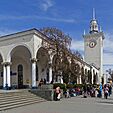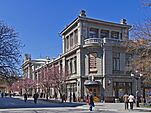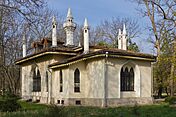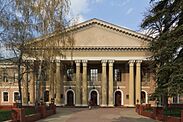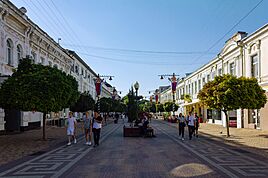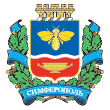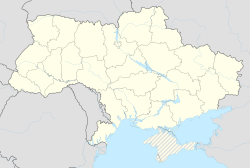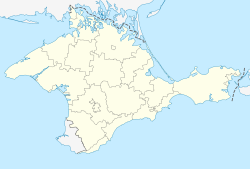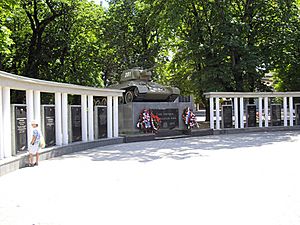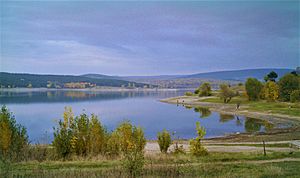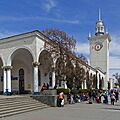Simferopol facts for kids
Quick facts for kids
Simferopol
|
|||
|---|---|---|---|
|
City
|
|||
| Ukrainian transcription(s) | |||
| • National | Simferopol | ||
| • ALA-LC | Simferopol′ | ||
| • BGN/PCGN | Simferopol’ | ||
| • Scholarly | Simferopol′ | ||
|
The railway station, Academic Drama Theater, Salgirka Park, Kebir-Jami, Trinity Cathedral, the State Medical University, Karl Marx Street
|
|||
|
|||
| Nickname(s):
Город пользы
The City of Usefulness (translation) |
|||
| Country | |||
| Autonomous republic | Crimea (de jure) | ||
| Raion | Simferopol Raion (de jure) | ||
| Federal subject | Crimea (de facto) | ||
| Municipality | Simferopol Municipality (de facto) | ||
| Founded2 | 15th century | ||
| Boroughs |
List
Zaliznychnyi District
Tsentralnyi District Kyivskyi District |
||
| Area | |||
| • Total | 107 km2 (41 sq mi) | ||
| Elevation | 350 m (1,150 ft) | ||
| Population
(2014)
|
|||
| • Total | 332,317 | ||
| • Density | 3,183.17/km2 (8,244.4/sq mi) | ||
| Demonym(s) | Simferopolitan | ||
| Time zone | UTC+3 | ||
| Postal code |
295000—295490
|
||
| Area code(s) | +7 3652 | ||
| Licence plate | AK(UA) 82(Rus) | ||
| Sister cities | Heidelberg, Kecskemét, Salem, Bursa, Eskişehir, Ruse, Nizhny Novgorod | ||
| Website | (Russian administration) | ||
| 1 United Nations General Assembly Resolution 68/262 2 Founded in 1784 as Simferopol, a Russian city. The settlement was previously known by the Crimean Tatar name Aqmescit. |
|||
Simferopol is the second-largest city on the Crimean Peninsula. It is also known as Aqmescit. The city is recognized by most countries as part of Ukraine. However, since 2014, it has been controlled by Russia. Russia considers Simferopol the capital of its Republic of Crimea.
Simferopol is a key center for politics, business, and transportation on the peninsula. It serves as the main city for both the Simferopol Municipality and the surrounding Simferopol District. In 2014, about 332,317 people lived there.
After the Russian Empire took over the Crimean Khanate in 1784, the Russian empress decided to build a new city. This city, Simferopol, was built where the Crimean Tatar town of Aqmescit (meaning "White Mosque") once stood.
Contents
What's in a Name?
The name Simferopol comes from the Greek word Sympheropoli. This means "city of common good" or "city of usefulness."
In the Crimean Tatar language, the city's name is Aqmescit. This means "the white mosque." However, "white" here doesn't mean the color of the building. It refers to the west direction in the traditional Turkic way of naming places. So, Aqmescit actually means "the Western Mosque."
A Look at History
Ancient Times and Early Settlements
Long ago, people lived in the area of modern Simferopol. Evidence of ancient people has been found in the Chokurcha cave.
Later, the Scythian Neapolis was built here. This was an ancient capital for the Crimean Scythian people. They lived in this area from about 300 BC to 400 AD.
The Crimean Tatars later founded the town of Aqmescit. For a time, Aqmescit was the home of the Qalğa-Sultan. This was the second most important leader in the Crimean Khanate, after the Khan. Today, this old part of the city is called Old Simferopol.
The Russian Empire Takes Over
In 1784, Simferopol was officially founded. This happened after the Russian Empire took control of the Crimean Khanate. The Russian Empress Catherine the Great gave the city its Greek name, meaning "city of usefulness." This was part of a plan to give Greek names to new cities in southern lands.
In 1802, Simferopol became the main city of the Taurida Governorate. During the Crimean War (1854–1856), the city was a base for Russian soldiers and a hospital. Many soldiers were buried near the city after the war.
Simferopol in the 20th Century
The 20th century brought more changes and conflicts to Simferopol. After the Russian Civil War, the city was taken by the Red Army in 1920. In 1921, Simferopol became the capital of the Crimean Autonomous Soviet Socialist Republic.
During World War II, Nazi Germany occupied Simferopol from 1941 to 1944. The city suffered greatly during this time. In April 1944, the Red Army liberated Simferopol.
Soon after, in May 1944, the entire Crimean Tatar population was forced to leave Crimea. They were sent to Central Asia. This was a punishment for some Tatars who were thought to have helped Nazi Germany.
Becoming Part of Ukraine
On April 26, 1954, Simferopol and the rest of Crimea became part of the Ukrainian Soviet Socialist Republic. This was a decision made by Soviet Premier Nikita Khrushchev.
In 1991, the Soviet Union broke apart. Simferopol then became the capital of the Autonomous Republic of Crimea within the newly independent Ukraine.
In the 1990s, Crimean Tatars were allowed to return home. Many came back to Simferopol. This led to new neighborhoods being built for them. Sometimes, there were disagreements over land ownership.
Recent Events: Russian Annexation
In March 2014, Russia took control of Crimea. Simferopol was then named the capital of a new Russian region called the Republic of Crimea. This was done by Russian president Vladimir Putin.
Before Russia took control, many Crimean Tatars in Simferopol protested. They wanted Crimea to remain part of Ukraine.
City Location and Weather
Where Simferopol Is Located
Simferopol is located in the central part of the Crimean Peninsula. The city sits on the Salhir River, next to the Simferopol Reservoir. This large artificial lake provides the city with clean drinking water. Its earth dam is the biggest in Europe.
Simferopol's Climate
The city has a climate that is mostly warm and humid. Winters are mild, and summers are hot. The average temperature in January is about 0.4°C (32.7°F). In July, it averages around 23°C (73°F). The city gets about 501 millimeters (19.7 inches) of rain each year. Simferopol also enjoys a lot of sunshine, with over 2,500 hours per year.
Getting Around Simferopol
Simferopol has important transportation links. These include a major railway station and an international airport.
Train and Bus Travel
The main railway station serves many travelers. Since 2014, the railway line to mainland Ukraine has been cut. Now, the station mainly handles local trains and a daily train to Moscow.
The city also has several main bus stations. You can take buses from Simferopol to many other cities in Crimea. These include Sevastopol, Kerch, Yalta, and Yevpatoriya.
Trolleybus and Airports
The Crimean Trolleybus system is very famous. It connects Simferopol to the city of Yalta on the Black Sea coast. This is the longest trolleybus line in the world. It stretches for about 96 kilometers (60 miles).
The Simferopol International Airport was built in 1936. It handles air travel for the city. Another smaller airport, Zavodskoye Airport, is located southwest of Simferopol. A new, modern terminal for the main airport was finished in 2018. It was designed to look like a wave.
People of Simferopol
In 2014, the population of Simferopol was 332,317 people. This makes it the largest city in the Republic of Crimea. Most people living in Simferopol are ethnic Russians. There are also Ukrainian and Crimean Tatar minorities.
Economy and Industry
Simferopol is home to several important industrial plants. These factories produce various goods. Some examples include:
- Fiolent, which makes power tools and electrical systems.
- Chemical industry plants.
- Factories that produce plastics.
- Plants that make electrical equipment and motors.
- Chornomornaftogaz, an energy company.
There are also plans for a "Digital Valley" near the airport. This area would focus on technology, computers, and microelectronics.
Learning and Education
Simferopol has the largest number of universities and colleges in Crimea.
- The Taurida V.Vernadsky National University is the biggest university in Simferopol and Crimea. It was founded in 1917.
- The Crimea State Medical University named after S. I. Georgievsky is a well-known medical school. It is located on land that was once a garden.
- A new campus for the V.I. Vernadsky Crimean Federal University opened in 2014.
Sports in Simferopol
Simferopol has its own football (soccer) club called FC TSK Simferopol. This team plays in the Crimean Premier League. The club was formed in 2014. It replaced the older Ukrainian club Tavriya Simferopol. Tavriya Simferopol was famous for being the first winner of the Ukraine Premier League. They also won the Ukrainian Cup in 2010.
Places of Worship
- Kebir-Jami Mosque, Simferopol
- Holy Trinity Cathedral, Simferopol
Famous People from Simferopol
- Max Alpert (1899–1980) – A Soviet photographer who took pictures during World War II.
- Andrei Abrikosov (1906–1973) – A Soviet actor for stage and film.
- Denis Bouriakov (born 1981) – A principal flautist for the Los Angeles Philharmonic orchestra.
- Dorofeeva (born 1990) – A singer, known as the female vocalist of the pop duo Vremya i Steklo.
- Sergey Karjakin (born 1990) – A chess prodigy who became a grandmaster at a very young age.
- Oleg Kotov (born 1965) – An Air Force colonel and a flight engineer on Soyuz missions.
- Alisa Melekhina (born 1991) – A chess master, attorney, and trained ballerina.
- Oleg Sentsov (born 1976) – A Ukrainian filmmaker, writer, and activist.
- Oleksandr Usyk (born 1987) – A heavyweight boxer and Olympic gold medalist.
- Yana Klochkova (born 1982) – A Ukrainian swimmer with five Olympic medals, including four gold.
- Hanna Rizatdinova (born 1993) – An individual rhythmic gymnast and Olympic bronze medalist.
- Kateryna Serebrianska (born 1977) – An individual rhythmic gymnast and Olympic gold medalist.
Sister Cities
Simferopol is "twinned" with several cities around the world. This means they have special friendly relationships.
 Salem, United States (1986)
Salem, United States (1986) Heidelberg, Germany (1991)
Heidelberg, Germany (1991) Kecskemét, Hungary (2006)
Kecskemét, Hungary (2006) Tepebaşı, Turkey (2007)
Tepebaşı, Turkey (2007) Bursa, Turkey
Bursa, Turkey Irkutsk, Russia (2008)
Irkutsk, Russia (2008) Moscow, Russia (2008)
Moscow, Russia (2008) Novocherkassk, Russia (2008)
Novocherkassk, Russia (2008) Omsk, Russia (2008)
Omsk, Russia (2008) Ruse, Bulgaria (2008)
Ruse, Bulgaria (2008) Nizhny Novgorod, Russia (2016)
Nizhny Novgorod, Russia (2016)
Images for kids
See also
 In Spanish: Simferópol para niños
In Spanish: Simferópol para niños


